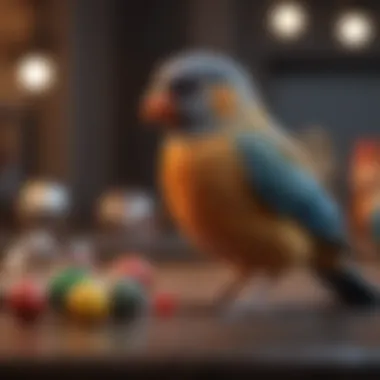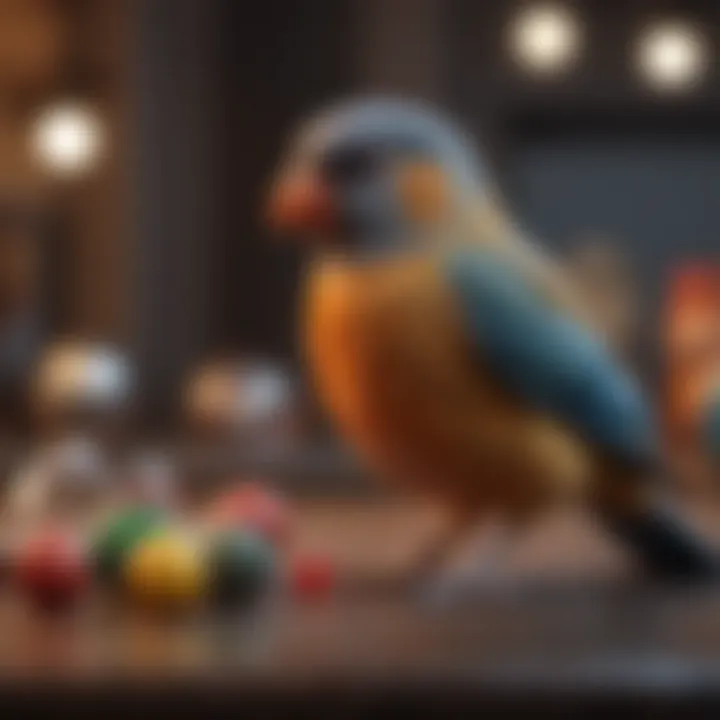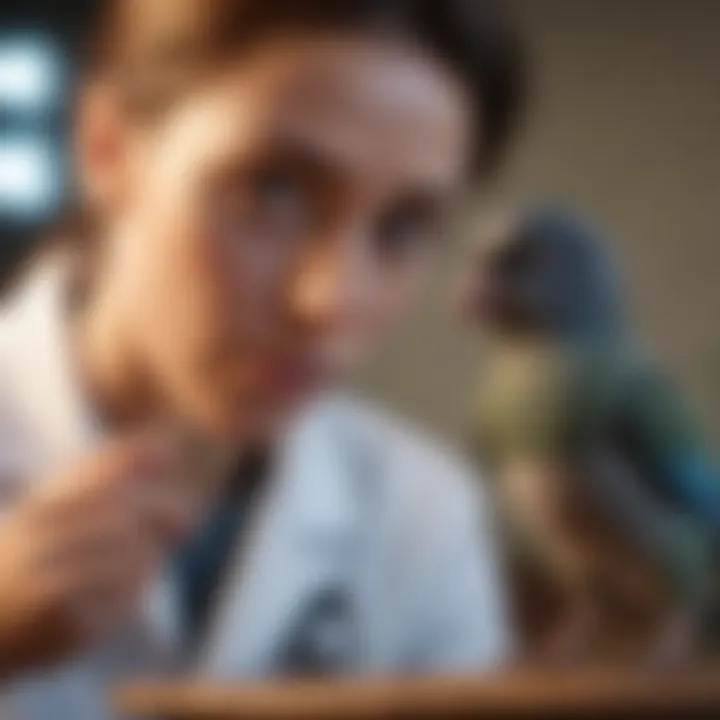Essential Considerations for Caring for Pet Birds


Intro
Caring for pet birds requires more than just a basic understanding of their needs. Successful bird ownership involves a deep awareness of various factors that directly impact avian well-being and happiness. Whether you are a seasoned bird owner or new to the avian world, knowing how to provide appropriate environments and interactions is vital. This article offers insightful guidelines that address core areas of care, enriched with practices to expand your knowledge.
Care Tips
Daily Care Routines
Establishing a consistent daily routine is crucial. Birds thrive on predictability and structure. Here are some essential tasks to include in your daily rituals:
- Feeding: Ensure that food is fresh and tailored to your bird's dietary needs. Remove uneaten food to prevent spoilage.
- Water: Change the water every day to maintain cleanliness.
- Social Interaction: Spend time interacting with your bird, as companionship is fundamental for their emotional well-being.
- Cage Check: Look over the cage for any needed adjustments or signs of wear.
Cage Setup and Maintenance
The habitat you create influences your bird’s quality of life. Selecting an appropriate cage is essential. Consider these aspects when setting up the cage:
- Size: Ensure the cage is spacious enough for your bird to move freely.
- Bar Spacing: Choose bars that are appropriately spaced to prevent escapes or injuries.
Maintenance should not be overlooked. Regularly inspect and clean the cage to uphold a healthy environment. Wash perches, toys, and food containers weekly.
Hygiene and Cleaning Practices
Maintaining hygiene is imperative for avoiding illnesses.
The following practices help:
- Daily Spot Cleaning: Swiftly remove droppings from surfaces.
- Deep Cleaning: Conduct deep cleanings bi-weekly to cleanse all components of the cage. Use safe, bird-friendly cleaning agents.
Seasonal Care Adjustments
Adapting care routines based on seasonal changes is key. During hotter months, ensure proper ventilation and avoid sun exposure. In winter, provide warmth without direct heat sources. Always observe your bird for changes in behavior as seasons shift.
Behavioral Insights
Understanding Bird Body Language
Birds communicate through body language. An understanding of their signals can enhance your bonding:
- Wing Position: Flapping can mean excitement, while tucked wings may indicate a relaxed state.
- Bobbing Head: Often a sign of curiosity.
Common Behavioral Issues and Solutions
Behavioral problems may arise. It is critical to understand these issues and seek solutions. Examples include:
- Feather Plucking: Often linked to boredom or stress; increasing social interaction or environmental enrichment could help.
- Aggression: Understanding triggers and respecting space can help minimize conflict.
Positive Reinforcement Techniques
Train your bird through encouragement rather than punishment. Reward desired behaviors with treats or praise to reinforce good habits.
Social Interaction Needs
Birds are social creatures. Fostering interaction, both with humans and other birds, is vital. Daily social engagement minimizes loneliness and promotes well-being.
Nutrition Guides
Essential Diet Components
A balanced diet is foundational. Core dietary components include:
- Pelleted food rich in nutrients.
- Fresh fruits and vegetables for additional vitamins.
- Some seeds can complement, but should not be the primary source.
Safe and Toxic Foods
Awareness of food safety is critical. Common foods to avoid are:
- Chocolate
- Avocado
- Caffeine
Supplements and Treats
Incorporating healthy treats can stimulate your pet. Always utilize safer options such as unsweetened, organic treats, and limit the quantity of occasional snacks.
Feeding Strategies for Different Species
Different bird species have diverse dietary famts. Research specific requirements, ensuring that feeding strategies cater to the unique needs of your bird.
Wellness and Health
Routine Health Checkups
Regular veterinary checkups play a significant role in preventative care. Schedule visits annually to monitor overall health.
Identifying Symptoms of Illness
Learn the signs indicating physical discomfort. Look for changes in appetite, droppings, or activity levels as possible red flags.
Preventative Care and Vaccinations


Discuss with your vet about necessary vaccinations and treatments tailored for your species. Ongoing preventive measures are crucial for avoiding diseases.
Mental and Emotional Well-being
Recognizing emotional health is vital. Ensure mental stimulation through varied activities and environments, vital to their overall satisfaction.
Enriching Activities
Toys and Playtime Ideas
Provide a variety of toys to satisfy their instinctual needs. Rotate toys regularly to keep things engaging. Remember to offer supervised and interactive playtime.
Training and Tricks
Engaging your bird in training challenges can build intelligence and create a stronger bond. Teach simple commands or tricks gradually, cementing the behavior with rewards.
Outdoor Activities and Interaction
Take your bird outside in a secure harness or travel cage. Exposure to new sights and sounds boosts their cognitive and emotional development.
DIY Projects for Mental Stimulation
Incorporate crafts and puzzles to challenge and entertain your bird. Simple such as paper mache toys or hiding treats can provide lasting enjoyment.
Providing quality care for your pet bird engenders not only longevity but a joyful and enriching life.
This guide aims to support both new and legacy bird owners in establishing vibrant environments tailored to their companion's needs. By paying attention to every detail, including housing, nutrition, and emotional aspects, every bird can lead a healthy, fulfilling life.
Prolusion to Pet Bird Ownership
Birds make wonderful companions that can enrich our lives in many ways. Owning a pet bird comes with unique responsibilities and joys. Understanding the fundamentals of pet bird ownership is crucial for anyone looking to welcome one into their home.
Understanding Bird Species
Bird species vary widely in behavior, size, and care requirements. Unique characteristics define each type. For instance, parakeets are sociable, while cockatoos tend to be more demanding of attention.
Considerations for species types involve the following points:
- Social needs: Some birds thrive in the company of others, while some prefer solitude.
- Lifespan: Many species like macaws can live for decades, making long-term commitment vital.
- Compatibility: Understanding which species can exist together safely is crucial for multi-bird households.
A proper understanding of these aspects can also help potential owners choose which species best fits their lifestyle. Scanning resources on sites like Wikipedia can give more insights into various species.
The Responsibility of Caring for Birds
Caring for a bird involves more than just providing food and water. Birds require environments that stimulate mental and physical well-being. Important factors include:
- Daily interaction: Birds are social and need attention and interaction from their owners.
- Health care: Regular check-ups with a veterinarian experienced with avian species ensure their health.
- Environment: A safe, spacious, and clean living environment is essential for happiness and reduced stress.
Bird ownership requires daily effort and ongoing commitment. Understanding these responsibilities leads to a fulfilling long-term relationship with your avian friend.
Taking the time to educate oneself about proper bird care is both a personal and a moral obligation, ensuring a happy life for your bird.
Essential Housing for Pet Birds
Creating an appropriate living environment for pet birds is crucial. The space you provide becomes their sanctuary, directly affecting their physical health and mental well-being. Unfortunately, choosing the correct housing can be tricky. Considering all factors, such as size, material, and layout, is essential for any bird owner. This section will address the essentials essential to ensuring the optimal habitat for your avian friend.
Selecting the Right Cage
When selecting a cage, noted points should easily be on the mind. The cage must be sturdy enough to house the type of bird you have. For instance, larger birds like macaws need tougher materials due to their strong beaks.
- Bar Spacing: Choose a mattress that keeps your bird safe. Bars that are too far apart can lead to accidents. For smaller birds, spaces should generally be tighter.
- Material: Stainless steel cages may be slightly more expensive, but they last longer and are easier to clean than other materials like painted wire.
- Accessibility: The cage must provide space for safe entry and exit. Look for possible hazards because getting in and out too easily may relax their safety, causing anxiety.
Overall, the right cage promotes a stress-free environment conducive to social interaction and exploration, which are signs of a healthy pet.
Sizing and Layout Considerations
After securing the proper form and material, focus on measuring. Sufficient space is key. Small cages can constrain movement and cause various health issues.
Birds need room not only to fly but to explore. Ideally, the following considerations should guide the selection process:
- Minimum Size Requirements: Different bird species have different space requirements. For example, budgies may thrive in a cage measuring 18 x 18 x 24 inches, whereas larger species require significantly larger homes.
- Cage Shape: Height can be just as important as width. A larger taller cage offers vertical space for enjoyment. Custom-shaped cages can provide interesting platforms.
- Perch Arrangement: Position perches at different heights for exercise. Variation in height promotes natural movement and enrichment.
The aim is to achieve balance between a spacious room for movement and a feeling of security to limit stress. Pay attention to noise levels too. Keeping noise away makes every corner feel like home.
Accessories for Comfort and Safety
Equipping the cage with accessories eases the transition into a new home. Just like humans, birds require visual and physical stimulation. Here are crucial elements to consider:
- Perches: Offer varying diameter perches to stimulate foot and leg actions, avoiding boredom and potential injury.
- Food and Water Bowls: Invest in easy-to-navigate bowls that prevent mess. Containers that cleanse easily will encourage use and conserve work for avian care.
- Hiding Spaces: Birds often seek shade when relaxed. Incorporating tents or plant materials informs them their space is secure and provides comfort.
- Toys: Rotate toys regularly to maintain interests. Stuff toys with treats to keep them occupied longer.
Providing a safe, supportive habitat can develop enviable behavior, keeping birds happy and healthy.
Focus on understanding functionalities. The way you surround any bird matters, emphasizing that consistent care extends well beyond cages alone.
Nutritional Needs of Pet Birds
A well-balanced diet is fundamental for the well-being of pet birds. Proper nutrition not only supports physical health but also impacts mental agility and emotional stability. As caretakers, it is the responsibility of bird owners to understand the specific dietary needs of their feathered companions. As such, the relevance of bird diets cannot be overstated, since an appropriate nutritional regime can significantly enhance the quality of life for pet birds.


Understanding Bird Diets
Birds have varied dietary needs that depend largely on their species. For instance, small parrots, like budgerigars, often favor seeds, while larger species might thrive on a diet rich in fruits and vegetables. Birds in the wild ingest a wide variety of foods, which means that replicating this diversity at home is crucial.
- Seed-based diets can lead to obesity and nutritional deficiencies.
- Fresh fruits and vegetables are vital for providing essential vitamins.
- Pelleted diets designed specifically for birds can offer a comprehensive solution.
Being aware of the natural behaviors and specific needs of pet birds ensures they receive the right nutrition and, thereby, live a healthier, longer life.
Commercial Vs.
Natural Diets
The debate between commercial and natural diets for pet birds raises important considerations. Commercial diets often come in pelleted forms, created with specific nutrients for different bird species. These meals ensure a balanced intake but can lack the variety found in natural diets.
Natural diets, which emphasize fresh produce, nuts, grains, and supplements, provide more diversity; however, finding the right balance is crucial. This includes:
- Understanding the proper portions of various food types.
- Recognizing that not all natural foods are appropriate for every bird.
Deciding between commercial and natural diets may depend significantly on the specific requirements of the bird. A diverse and well-thought-out diet can prevent health issues while also ensuring pet birds enjoy their meals not out of necessity but from a wide range of options.
Identifying Safe Foods and Toxic Substances
Identifying edible food and knowing what is toxic is fundamental for pet bird care. Although many foods are safe for birds, others can lead to condition. Recognizing those affected groups is essential. Recommended safe foods include:
- Fruits: Apples (without seeds), berries, bananas
- Vegetables: Carrots, leafy greens, broccoli
- Grains: Brown rice, quinoa, oats
To create a safe environment, owners also need awareness of common toxic substances, for instance:
- Avocado - Can cause heart failure.
- Chocolate - Toxic to birds and may lead to poisoning.
- Caffeinated beverage - Can stimulate a bird’s heart, possibly leading to death.
Proper knowledge of feeding can lead to better health and increase longevity for birds.
Behavioral Insights and Enrichment
Understanding your bird's behavior is fundamental to their health and happiness. Pet birds are not just charming companions; they are sentient beings with emotional and psychological needs. When owners take the time to learn about how pet birds behave, it fosters a more fulfilling relationship. Providing behavioral insights and enrichment opportunities can significantly enhance the life of your pet bird.
Understanding Bird Behavior
Birds communicate through various behaviors. It’s important to observe signals through vocalizations, body language, and movement. For instance, when a bird fluffs up its feathers, it might be feeling content or relaxed. Conversely, a bird that is restless and screams may be signaling stress or boredom.
Familiarizing oneself with specific species behavior can help in interpreting these signals. Parrots, for example, are known for their highly social nature and desire for interaction. On the other hand, certain finches may prefer more solitude.
- Seek to Observe: Spend time watching your bird’s activities. Pay attenton to their unique preferences.
- Communication: Talk daily with your bird. Vocabulary helps in social reinforcement.
Creating Enriching Environments
Creating an enriching environment goes beyond aesthetics—it's about meeting the innate needs of birds to explore, forage, and interact. Birds are intelligent and curious, often needing stimulation that mimics their natural habitats.
Consider these vital elements in your approach:
- Cage Size and Layout: Ensure that the cage provides enough space for movement and that it is designed to accommodate climbing and play.
- Natural Elements: Incorporate natural materials such as untreated wood perches and safe indoor plants like spider plants or pothos. These not only beautify the cage but also encourage natural behaviors.
- Variety of Spaces: Transition areas between hiding spots, flat surfaces for exploring, and places for hanging toys contributes to a welcoming environment.
Importantly, abundance in spatial options reduces stress. Touch and smells from various materials provide endless stimuli for your pet bird.
Interactive Toys and Activities
Interactive toys engage birds physically and mentally. Choosing the right toys goes a long way in promoting well-being.
- Foraging Toys: These allow birds to search for treats or hidden food, simulating natural foraging behavior.
- Puzzle Toys: They challenge your bird’s intellect, thus encouraging problem solving. Options include those with different difficulty levels accommodating various species.
- Social Games: Activities involving interaction and bonding, like playing peek-a-boo with mirrors or beads, stimulate performance and communication skills.
Health and Wellness for Pet Birds
The health and wellness of pet birds are critical factors that contribute to their overall happiness and longevity. Birds, like any other pets, require dedicated care and attention to ensure they remain healthy and vibrant. Monitoring your bird's wellness involves understanding their specific needs, recognizing signs of illness, and implementing routine checks that foster better living conditions.
Routine Health Assessments
Routine health assessments are the foundation ofbird care. These evaluations can begin with visual inspections of your bird’s physical condition. Regular observation helps owners identify any changes in behavior, appearance, or appetite, which could be early signs of an issue.
It is prudent to perform regular check-ups, including:
- Feather condition: Healthy feathers are clean and vibrant. Dull or missing feathers may indicate nutritional deficiencies.
- Eye clarity: Clear, bright eyes are a sign of good health, while redness or cloudiness can be concerning.
- Beak and nails: Both should remain well-groomed and not overgrown, as these can become breeding grounds for bacteria.
- Weight: Weighing your bird periodically helps you track weight changes that can signal health issues.
Aside from self-checks, scheduling consistency visits to an avian vet is vital for professional assessments. A vet can offer more detailed insights and check factors beyond simple observations, contributing to a long-term care strategy.
Common Health Issues in Birds
Preventing illness is more effective than treating it. Knowing what health issues are common amongst the various species of birds gives owners an edge in keeping their avian friends safe. Here are some of the noted health concerns that bird owners should watch for:
- Obesity: Often from a poor diet, obesity can lead to severe health complications.
- Feather plucking: Stress or boredom can cause this behavioral issue.
- Respiratory infections: Birds are susceptible to airborne pathogens leading to serious respiratory problems.
- Gout: Resulting from an improper diet, this condition can be painful and debilitating.
Keeping quality check on birds for these conditions early may help in managing and even preventing escalation to severe health problems, just as being attuned to subtle behavioral adjustments might hint toward underlying issues.
“Studies emphasize the link between a bird's environment and its overall health.”
Preventive Care and Veterinary Visits
Preventive care should take center stage in every bird owner's checklist. Factors to consider for preventive health care include:


- Routine vet visits: Establishing a schedule with a qualified vet can address potential health threats early.
- Vaccinations and treatments: Certain birds may require vaccines or medications at certain intervals.
- Environmental hygiene: Regular cleaning of cages and avoidance of toxins can minimize infection risk.
- Continuous learning: Stay updated by reading about bird health and connecting with knowledgeable individuals in communities through forums like Reddit.
Visiting an avian vet isn’t just during dire situations. Fostering a positive relationship with a vet specialties in bird care will enable you to maintain your bird’s wellness easily. With informed owners and the right care strategies, birds can thrive throughout their lives, indicating the pivotal role of diligent health monitoring in bird ownership.
Socialization and Bonding with Your Bird
Socialization and bonding with your bird are vital components of avian care. Building a strong relationship enriches their lives and ensures better physical and emotional well-being. A well-socialized bird is typically more comfortable around humans and less likely to exhibit negative behaviors, such as biting or excessive screeching. Understanding how to meet their social needs establishes a stable environment that is reassuring for both the pet and the owner.
Understanding Social Needs
Birds are social creatures. In the wild, they live in flocks, which influences their social behavior. Understanding this aspect is crucial when keeping birds as pets. They thrive on interaction—not only with other birds but also with their human caregivers. Sound and chirping are their primary means of communication. You need to recognize that birds express themselves through vocalizations. By paying attention to these sounds, you can gauge their mood and social requirements.
Maintaining social contact with your bird helps ward off loneliness, leading to a healthier and more engaging life. Potential advantages include:
- Reduction of stress behaviors. Birds that feel isolated may develop negative habits, such as feather plucking or excessive screeching.
- Improved confidence. Socialized birds are often more adventurous and willing to explore their environment.
- Enhanced interaction. An engaging bird creates a more vibrant home atmosphere.
Techniques for Building Trust
To foster trust with your bird, it's essential to engage consistently and gently. There are several effective techniques to build that bond, including:
- Routine Handling. Regular handling, while using a calm voice, helps your bird feel more secure.
- Positive Reinforcement. Use treats as rewards during initial interactions. It helps the bird connect good experiences with your presence.
- Consistent Timing. Birds benefit from predictability. Set aside time daily for bonding, allowing your bird to anticipate interaction.
The trust-building process takes time and patience. Respect your bird’s space, and allow it to approach at its own pace. Over time, as your bird learns that you are a source of safety and comfort, the bond will strengthen, enhancing your cohabitation experience.
"Social interactions have shown to promote psychological well-being in birds, making convivivality a recommended practice among pet avian caregivers."
Traveling with Pet Birds
Traveling with pet birds can be both rewarding and challenging. Many bird owners may need to transport their feathered companions for a variety of reasons, such as moving to a new home or taking a vacation. Understanding the unique needs of birds during travel helps ensure their safety and well-being. Preparing in advance might reduce stress for the birds and create a more pleasant experience for owners. This is vital for avoiding any harm to the bird and ensuring a smooth journey.
Preparing Your Bird for Travel
Before traveling, owners need to assess their bird's personality and acclimatize it to the travel situation. Some birds may feel anxious in new environments or during transport, while others adjust with ease. Here are crucial steps to take:
- Practice Short Trips: Begin with short journeys. This gets the bird used to the travel cage and reduces anxiety over time.
- Familiarize with the Cage: Allow the bird to explore the travel cage before the actual trip. Add familiar items from their regular environment to provide comfort.
- Keep Exposure Gradual: Slowly introduce the carrier to the bird to create a positive association before travel day.
Pre-pack items that can make the journey easier . This can include food, water, and any medication necessary for the duration of the trip.
Safety Precautions During Travel
Safety should always be a top priority when transporting birds. Meeting specific conditions mitigates risks and ensures that your birds are not subjected to unnecessary stress. Consider the following tactics:
- Select an Appropriate Cage: The travel cage should be secure, well-ventilated, and have sufficient space for the bird to move. Ensure it is escape-proof.
- Avoid Temperature Extremes: Birds are sensitive to temperature changes. Ensure the temperature inside the vehicle remains moderate and avoid leaving them exposed to direct sunlight for a prolonged time.
- Minimize Noise and Chaos: Birds may easily get startled, so reducing noise is crucial. Consider covering the cage partially to provide a calm and cozy atmosphere.
- Regular Breaks: Take breaks during long journeys; check on the bird, refresh their water, and ensure they have ample room to adjust.
Always prioritize your bird’s comfort and safety during travel to avoid an anxiety-filled experience.
By addressing these specific elements in traveling with pet birds, he owners can facilitate a smoother transit process, ensuring a pleasant journey as well as their subsequent adaptation to new surroundings. Each step contributes to deeper bonding and a respectful understanding of the bird's various needs. This approach ensures that caring for pet birds extends comfortably into all aspects, including travel.
Pet Bird Adoption Considerations
Adopting a pet bird is not a whimsical decision. Each bird species comes with unique traits that dictate its care. Understanding these traits is essential for creating a harmonious home. Adopting involves considering both the needs of the bird and the constraints of the potential owner’s lifestyle. A well-informed approach ensures a robust bond between the bird and its caretaker.
Researching Breed-Specific Needs
The various bird species have distinct characteristics, and each has specific needs that should be understood before adopting. Species such as parrots, finches, and canaries all have different social behaviors, diets, and exercise needs.
- Social Interaction: Some species, like budgerigars and cockatiels, thrive on social interactions. They often need companionship and will exhibit loneliness if left alone excessively.
- Feeding Routines: Finches prefer seeds and vegetables, while parrots require a varied diet including fruits and pellets. It is crucial to adjust the feeding routine based on the bird’s specific dietary needs.
- Space Requirements: Different birds require different living spaces. For example, larger birds, such as macaws, need spacious cages along with adequate room for flying and exercising - ideally about 4 ft by 4 ft. Small canaries can adapt to smaller cages, but even tiny birds benefit from adequate space.
Before deciding, take the time to further research the specific breeds that interest you. This fosters a successful adaptation and enriches the lifecycle of both the pet and owner.
Adoption from Shelters and Rescues
Supporting local shelters is a commendable way to adopt pet birds. Many national rescue groups specialize in avian adoption, providing future owners the chance to offer loving homes to birds that may be abandoned or neglected.
- Diverse Choices: Rescues often have multiple species available. This allows potential owners to select a bird that fits well with their environment and lifestyle. Find information by visiting organizations such as the Bird Advocates Group or the National Bird Rescue and Rehabilitation.
- Cost-Effectiveness: Adopting from these places is usually less expensive than buying birds from pet stores. It often includes basic care, vaccinations, and sometimes even critical supplies.
- Building Awareness: Many rescue organizations provide education on bird care, along with proper adoption guidance. They help new pet owners understand potential behaviors and challenges, preparing them effectively for the responsibilities ahead.
Adopting from shelters creates an opportunity while aligning with welfare responsibility. Ethical adopters become a part of the solution, transforming the plight of these birds into something more hopeful.
Adoption goes futher than just home-giving. It brings harmony by supporting the wellbeing of the species and creates rewarding bonds for humans and birds together.
Culmination and Future Considerations
Assessing topics like the conclusion and future considerations on pet bird care imparts valuable insights. It brings to light the ongoing nature of avian care, underscoring that ownership is not simply a one-time commitment but a continual journey. Noticing how birds adapt and thrive based on their living situation reminds us of the responsibilities we bear as caretakers. The insights gathered from the entirety of this article aim to reinforce your knowledge base while preparing you for potential future challenges.
Reflecting on the Ownership Journey
Every pet bird ownership journey is different, marked by unique experiences and life lessons. Reflecting on this journey is crucial. Individual circumstances will mold how one connects with their feathered friend.
- Personal triumphs and struggles give shape to future approaches in bird care.
- Adapting your methods to react to changing behavior of your bird helps maintain a harmony within your home.
Set aside some moments to not only observe your bird's daily actions but to assess your responsive techniques. These evaluations can enhance trust between you and your bird. Being mindful of your bird's evolving needs leads to more effective care. Good observation allows prehistoric traits of birds to surface. Remember, they are not merely companions but sentient beings therefore understanding species-specific needs can lead to improving the bond you have established over time.
Continued Education and Learning
A commitment to ongoing education and learning ensures the well-being of your pet. The avian world is vast and diverse. Each species presents different needs and behaviors, which may evolve. Regularly seeking new knowledge allows you will stay informed on best practices in bird care.
Consider:
- Attending workshops or trainings from recognized avian organizations
- Joining local or online forums and communities on Reddit or Facebook
- Reading recent articles or scientific studies pertaining to bird health and nutrition
An informed bird owner drastically reduces the risks associated with potential health problems or misinterpretations of behavior by actively seeking out knowledge and understanding. Engaging with counterparts who share the same interest in the avian care can make this journey much more fulfilling. Thus, dedication to education provides more than just information. It grants peace of mind when confronting the uncertainties of bird ownership.
Fostering an environment where learning is continuous creates opportunities for connections and enrichment within the shared household between bird and caregiver. Every step builds on the last, ensuring happiness and health for both divisions involved in bird care.















